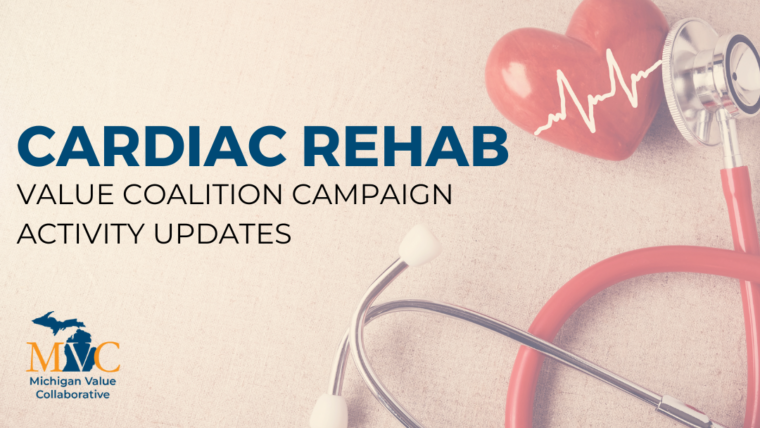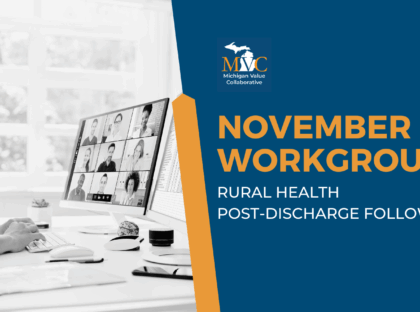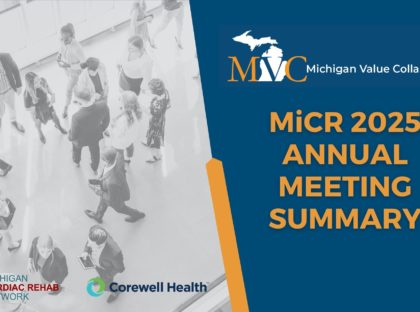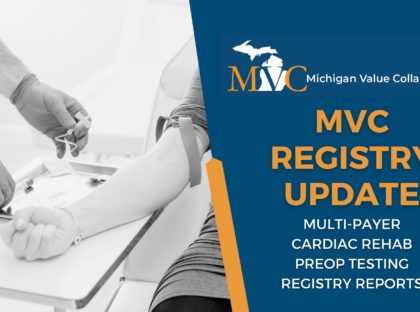Cardiac rehabilitation (CR) is designed to improve cardiovascular function and mitigate risk factors for future cardiovascular events through monitored exercise, patient education, lifestyle modifications, smoking cessation, and social support (1). For over a decade, CR has been a Class I indication in clinical guidelines for patients who have had a heart attack, chronic stable angina, chronic heart failure, or have undergone a percutaneous coronary intervention (PCI), surgical (SAVR) or transcatheter aortic valve replacement (TAVR), or coronary artery bypass grafting (CABG). The evidence supporting CR as a high-value therapy for patients is clear: better long-term survival, fewer secondary cardiovascular events, fewer readmissions, improved quality of life, and lower healthcare utilization (2–6).
Unfortunately, only a fraction of Michigan residents eligible for CR attend a single session following hospitalization for a qualifying condition, with rates as high as 59% for patients undergoing CABG and as low as 4% for patients with congestive heart failure (CHF) (see Figure 1). These data highlight that we as a state are well short of the national goal set by the Million Hearts Initiative of 70% enrollment for all eligible patients. Data from Michigan also suggests wide variation in CR enrollment across hospitals that are not fully explained by differences in patient case-mix (7).
Figure 1. Collaborative-wide CR enrollment rates for qualifying conditions (01/2017-12/2019)
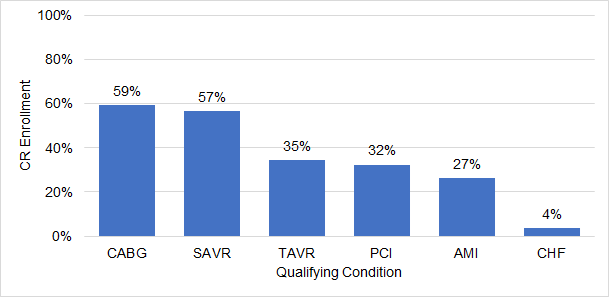
Since 2019 the MVC Coordinating Center sought to equitably increase participation in CR for all eligible individuals in Michigan in partnership with the Blue Cross Blue Shield Cardiovascular Consortium (BMC2) and the Michigan Society of Thoracic and Cardiovascular Surgeons Quality Collaborative (MSTCVS-QC). In an effort to drive improvement in this area across the collaborative’s membership, MVC developed a number of resources and strategies. For example, the MVC Coordinating Center built hospital-level reports that provide members with information on CR enrollment across eligible conditions benchmarked against all MVC hospitals. This week the newest iteration of this CR report was distributed to members. The previous version of the report was sent in March 2021 with a reporting period of 1/1/17 – 12/31/19. The latest version shifted that reporting period by six months (7/1/17 – 6/30/20), included Medicaid episodes for the first time, expanded the time horizon from 90 days to one year, and added information on CHF and acute myocardial infarction (AMI) episodes.
With the addition of CHF and AMI (both “high-volume” MVC conditions), the number of hospitals eligible to receive a CR report doubled from 47 to 95, so many MVC hospitals received this report for the first time this month. The most significant methodological change compared to the previous report was the expansion of the episode window from 90 days to 365 days (one year). Previous reports undercounted the number of CR visits by using the standard MVC episode length of 90 days when a full CR program consists of 36 sessions, which are often not feasible to complete in 90 days. Therefore, it was important to expand the time horizon to achieve a fuller count. The report instead looked one full year beyond the index event (either PCI, TAVR, SAVR, CABG, CHF, or AMI) to calculate CR utilization rates and number of visits.
The MVC team also convened a multidisciplinary stakeholder group of CR practitioners, physicians, and CQI leaders to foster discussion around barriers and facilitators to CR enrollment. Many of the recent changes to the CR reports were a direct result of suggestions from this stakeholder group. Quarterly seminars have also provided opportunities for local facilities to share ongoing quality improvement activities and to learn from national leaders about innovations in the delivery and quality of CR.
More recently, the MVC team conducted virtual site visits with several CR facilities around the state to learn about their programs, the successes and challenges they have encountered, and ways to improve collaboration in Michigan around CR enrollment. Common themes emerged as barriers to CR enrollment, including lack of patient or physician engagement, geographical and/or technological gaps in care between the hospital and CR facility, and insurance coverage and reimbursement. Through collaborative learning and dissemination of best practices, the MVC Coordinating Center believes that its members can begin to address many of these challenges moving forward.
These efforts are all the more important as CR facilities begin to recover from the effects of the COVID-19 pandemic. Many facilities had to reduce capacity and staff as a result of the pandemic, and the number of CR visits declined significantly compared to pre-pandemic months (see Figure 2). While many CR facilities are back to operating at full capacity, continued efforts will be needed to return CR enrollment to pre-pandemic levels. Some sites in Michigan have adopted virtual, home-based, or hybrid versions of CR to continue providing care to patients throughout the pandemic, and its place as a substitute for facility-based CR will require continued exploration that can be supported through collaborative efforts.
Figure 2. Changes in CR enrollment from 2019 to 2020 over time and by qualifying condition

While many challenges remain to achieve the national goal of 70% enrollment in CR for eligible individuals, the MVC Coordinating Center is optimistic that its current and planned efforts will provide opportunities for Michigan to lead the way. If you are interested in joining our efforts to equitably increase CR enrollment for eligible patients in Michigan, please reach out for more information at michiganvaluecollaborative@gmail.com.
References
- Rubin R. Although Cardiac Rehab Saves Lives, Few Eligible Patients Take Part. JAMA [Internet]. 2019 Jul 17; Available from: http://dx.doi.org/10.1001/jama.2019.8604 PMID: 31314061
- Heran BS, Chen JM, Ebrahim S, Moxham T, Oldridge N, Rees K, Thompson DR, Taylor RS. Exercise-based cardiac rehabilitation for coronary heart disease. Cochrane Database Syst Rev. 2011 Jul 6;(7):CD001800. PMCID: PMC4229995
- Taylor RS, Long L, Mordi IR, Madsen MT, Davies EJ, Dalal H, Rees K, Singh SJ, Gluud C, Zwisler A-D. Exercise-Based Rehabilitation for Heart Failure: Cochrane Systematic Review, Meta-Analysis, and Trial Sequential Analysis. JACC Heart Fail. 2019 Aug;7(8):691–705. PMID: 31302050
- Taylor RS, Brown A, Ebrahim S, Jolliffe J, Noorani H, Rees K, Skidmore B, Stone JA, Thompson DR, Oldridge N. Exercise-based rehabilitation for patients with coronary heart disease: systematic review and meta-analysis of randomized controlled trials. Am J Med. 2004 May 15;116(10):682–692. PMID: 15121495
- Anderson L, Thompson DR, Oldridge N, Zwisler A, Rees K, Martin N, Taylor RS. Exercise‐based cardiac rehabilitation for coronary heart disease. Cochrane Database Syst Rev [Internet]. John Wiley & Sons, Ltd; 2016 [cited 2021 Jan 25];(1). Available from: https://www.cochranelibrary.com/cdsr/doi/10.1002/14651858.CD001800.pub3/abstract
- Rejeski WJ, Foy CG, Brawley LR, Brubaker PH, Focht BC, Norris JL 3rd, Smith ML. Older adults in cardiac rehabilitation: a new strategy for enhancing physical function. Med Sci Sports Exerc. 2002 Nov;34(11):1705–1713. PMID: 12439072
- Thompson MP, Yaser JM, Hou H, Syrjamaki JD, DeLucia A 3rd, Likosky DS, Keteyian SJ, Prager RL, Gurm HS, Sukul D. Determinants of Hospital Variation in Cardiac Rehabilitation Enrollment During Coronary Artery Disease Episodes of Care. Circ Cardiovasc Qual Outcomes. American Heart Association; 2021 Feb;14(2):e007144. PMID: 33541107
